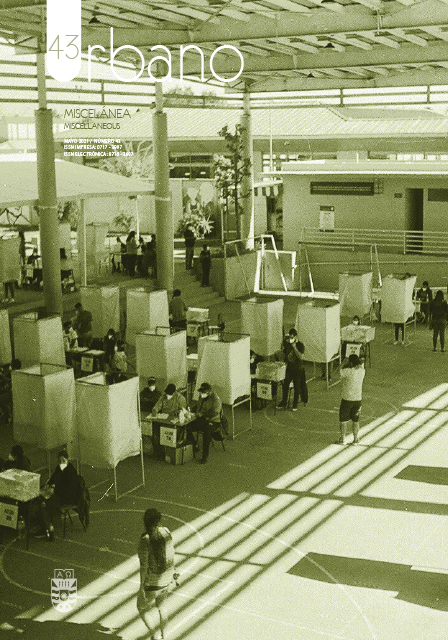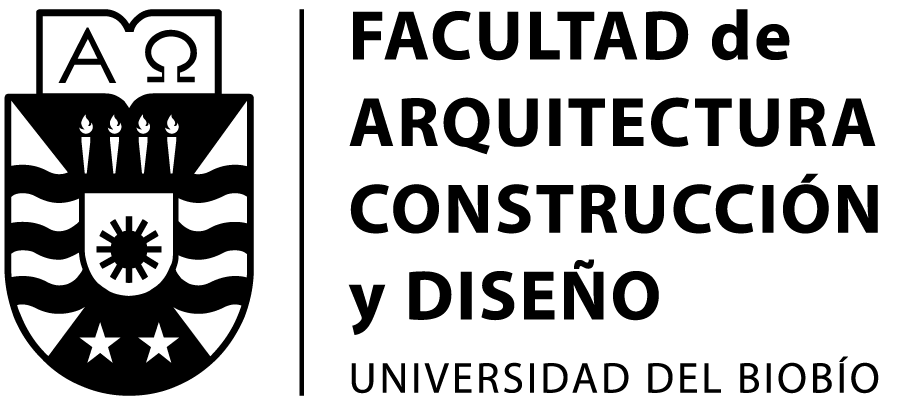Diffuse urban sprawl in intermediate cities. Simulation of the expansión process in the city of Temuco, Chile
DOI:
https://doi.org/10.22320/07183607.2021.24.43.06Keywords:
simulation, markov ahains, cellular automaton, multicriteria-multi-objective assessment, geographic information systemsAbstract
Urbanization advances vertiginously and its impacts are visible beyond metropolitan spaces. In this context, urban sprawl simulation methodologies become relevant to understand and add to future urban growth scenarios. In this work, the case of the city of Temuco in the La Araucanía Region is analyzed, using the following tools: Markov chains; Cellular Automaton; Multicriteria-Multi-objective Assessment; and the determination of land usage/cover using Geographic Information Systems (GIS). Based on the above, the urban scenario was determined for 2049 from the spatial patterns of the area under study, since 1985. The model shows a trend to a peripheral and diffuse sprawl towards the north of the city and a strong development towards the western sector in the Labranza neighborhood. That is to say, the first sector is projected as a possible node of expansion, and the second, as one of consolidation. It is concluded that both zones require pertinent updated urban planning instruments, which the city has not had until now.
Downloads
References
BARTHELEMY, M. (2016). The Structure and Dynamics of Cities. Cambridge: University Printing House.
BATTY, M. (2005). Cities and Complexity: Understanding Cities with Cellular Automata, Agent-Based Models, and Fractals. Cambridge: MIT Press.
BATTY, M. (2013). The New Science of Cities. Cambridge: MIT Press.
BELLET, C. Y SPOSITO, M. (Eds.) (2009). Las ciudades medias o intermedias en un mundo globalizado. Lleida: Universitat de Lleida.
CONGALTON, R. (1991). A review of assessing the accuracy of classifications of remotely sensed data. Remote Sensing of Environment, 37(1), 35-46. DOI: https://doi.org/10.1016/0034-4257(91)90048-B
ENTCHEVA-CAMPBELL, P., ROCK, B., MARTIN, M., NEEFUS, C., IRONS, J., MIDDLETON, E. Y ALBRECHOVA, J. (2004). Detection of initial damage in Norway spruce canopies using hyperspectral airborne data. International Journal of Remote Sensing, 25(24), 5557-5584. DOI: https://doi.org/10.1080/ 01431160410001726058
GARÍN, A., SALVO, S. Y BRAVO, G. (2009). Segregación residencial y políticas de vivienda en Temuco. 1992-2002. Revista de Geografía Norte Grande, (44), 113-128. DOI: http://dx.doi.org/10.4067/S0718-34022009000300006
HENRÍQUEZ, C. (2014). Modelando el crecimiento de ciudades medias: Hacia un desarrollo urbano sustentable. Santiago: Ediciones Pontificia Universidad Católica de Chile.
HENRÍQUEZ, C. Y QÜENSE, J. (2010). Evaluación multicriterio/multiobjetivo aplicada a los usos y coberturas de suelo en la cuenca de Chillán. Revista Tiempo y Espacio, (25), 1-15. http://revistas.ubiobio.cl/index.php/TYE/ article/view/1767/1711
Instituto Nacional de Estadísticas [INE] (2017). Censo 2017. Base Redatam.
KHARAT, M., KAMBLE, S. J., RAUT, R., KAMBLE, S. S. Y DHUME, S. (2016). Modeling landfill site selection using an integrated fuzzy MCDM approach. Model. Earth Syst. Environ. 2(2). DOI: https://doi.org/10.1007/ s40808-016-0106-x
KOKALY, R. F. (2001). Investigating a physical basis for spectroscopic estimates of leaf nitrogen concentration. Remote Sens. Environ. 75, 153- 161. DOI: https://doi.org/10.1016/S0034-4257(00)00163-2
Laboratorio de Planificación Territorial - Universidad Católica de Temuco (2013). Diagnóstico Territorial Sector de Labranza. Informe en el marco del curso de Taller de Proyectos por solicitud del Comité Social Procomuna de Labranza.
MALCZEWSKI, J. (1999). GIS and Multicriteria Decision Analysis. New York: John Wiley & Sons.
MATURANA, F. Y ROJAS, A. (Eds.) (2015). Ciudades intermedias en Chile: Territorios olvidados. Santiago: RIL Editores.
Ministerio de Planificación (2017). Ley 19253 Establece Norma sobre Protección, Fomento y Desarrollo de los indígenas, y crea la Corporación Nacional de Desarrollo Indígena. Recuperado de https://www.leychile.cl/ Navegar?idNorma=30620yidVersion=2017-11-03
MORALES, M. Y MATURANA, F. (2019). Análisis de patrones espaciales en la expansión urbana de ciudades intermedias. el caso de San Fernando. Revista Cuadernos de Vivienda y Urbanismo, 12(24). DOI: https://doi. org/10.11144/Javeriana.cvu12-24.apee
PEÑA, F. Y ESCALONA, M. (2009). Expansión urbana en la intercomuna Araucanía centro. Alteraciones sobre las áreas rurales. En Hidalgo, R., De Mattos, C. y Arenas, F. (Eds.), Chile: De país urbano al país metropolitano (pp. 389-398). Santiago: Pontificia Universidad Católica de Chile.
PEÑA-CORTÉS, F., PINCHEIRA-ULBRICH, J., ROZAS-VÁSQUEZ, D., FERNÁNDEZ, E. Y RAMÍREZ, F. (2020). Experiencia metodológica en la definición de áreas para el emplazamiento de equipamiento en La Araucanía. Un aporte para la elaboración de los Planes Regionales de Ordenamiento Territorial. En Escalona M., Muñoz-Pedreros, A. y Figueroa, D. (Eds.). Hacia (para) una gobernanza ambiental. Reflexiones desde la Araucanía (pp. 315-350). Santiago: RIL editores.
Región de La Araucanía: Senadora ingresa oficio para crear una nueva comuna (12 abril 2018). La Tercera. Recuperado de https://www.latercera. com/nacional/noticia/region-la-araucania-senadora-ingresan-oficio-crear-una-nueva-comuna/131324/#
ROJO-MENDOZA, F., ALVARADO-PETERSON, V., OLEA-PEÑALOZA, J. Y SALAZAR-BURROWS, A. (2020). Definiendo el Temuco metropolitano: Consideraciones para un nuevo modelo de urbanización extendida en la Araucanía. Revista AUS, (27), 41-49. DOI: https://dx.doi.org/10.4206/aus.2020.n27-05
SAATY, T. (1980). The Analytic Hierarchy Process. New York: McGraw-Hill.
SALAZAR, G., IRARRÁZAVAL, F. Y FONCK, M. (2017). Ciudades intermedias y gobiernos locales: Desfases escalares en la Región de la Araucanía, Chile. Revista Eure, 43(130), 161-184. DOI: https://dx.doi.org/10.4067/s0250- 71612017000300161
VAN DER MERWE, J.H. (1997). GIS-aided evaluation and decision-making for regulating urban expansion: A South African case study. GeoJournal, 43(2), 135-151.
Downloads
Published
How to Cite
Issue
Section
License
Copyright (c) 2021 Francisco Maturana, Fernando Peña-Cortés, Mauricio Morales, Carlos Vielma-López

This work is licensed under a Creative Commons Attribution-ShareAlike 4.0 International License.
The content of articles which are published in each edition of Habitat Sustentable, is the exclusive responsibility of the author(s) and does not necessarily represent the thinking or compromise the opinion of University of the Bio-Bio.
The author(s) conserve their copyright and guarantee to the journal, the right of first publication of their work. This will simultaneously be subject to the Creative Commons Recognition License CC BY-SA, which allows others to share-copy, transform or create new materials from this work for non-commercial purposes, as long as they recognize authorship and the first publication in this journal, and its new creations are under a license with the same terms.![]()























